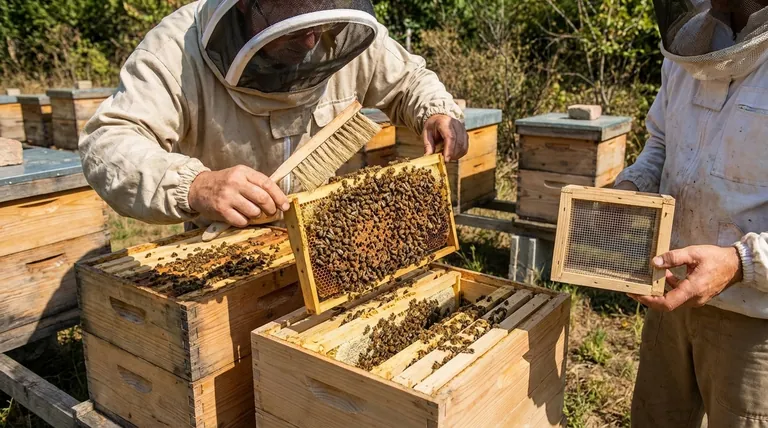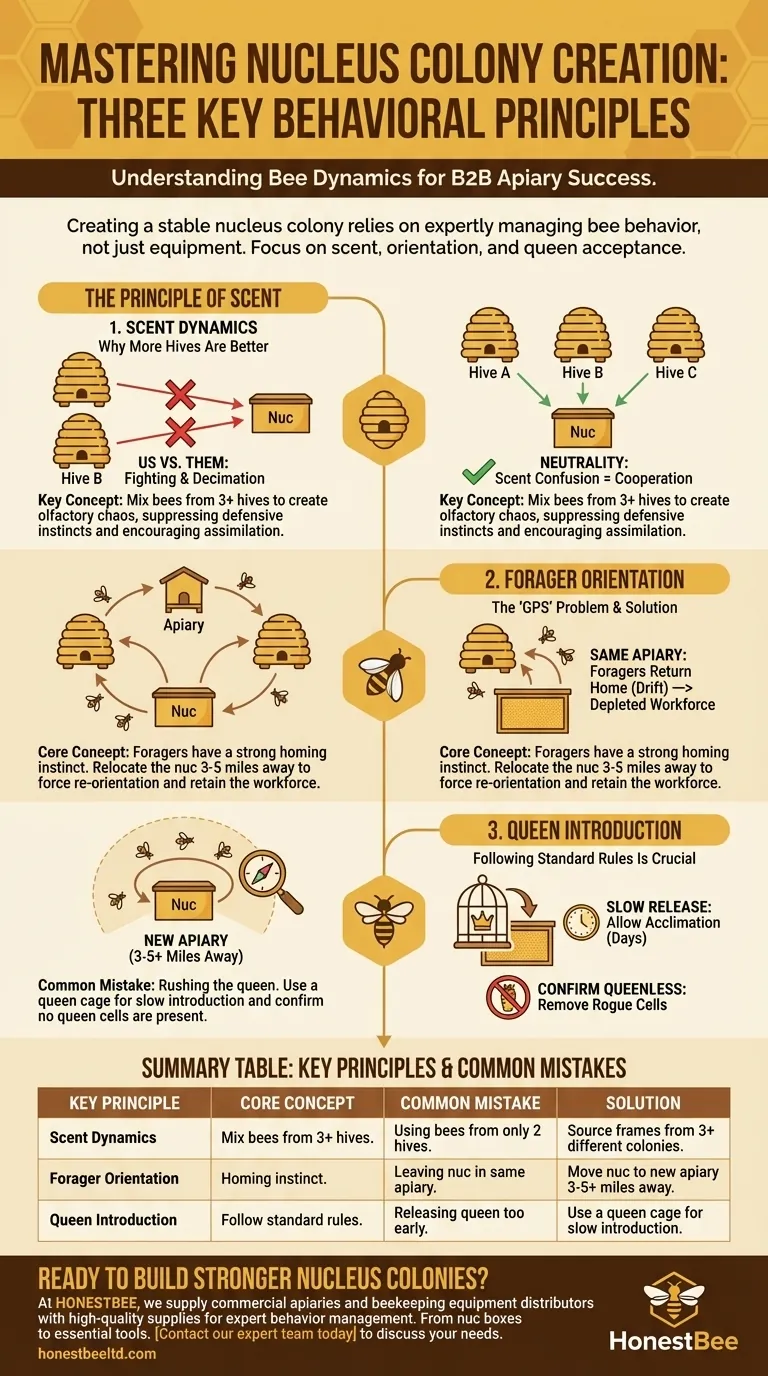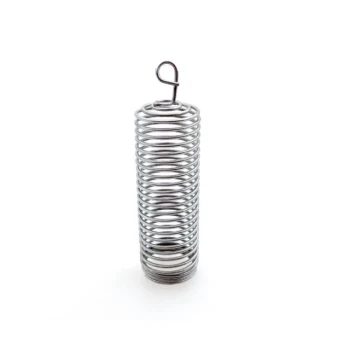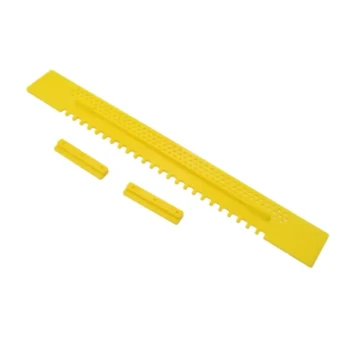When creating a nucleus colony, there are three fundamental principles of bee behavior you must understand to ensure success. These are: the dynamics of combining bees from different hives, the homing instinct of forager bees, and the standard rules for introducing a new queen. Mastering these concepts prevents common failures like infighting, colony collapse from a lost workforce, and queen rejection.
Creating a stable nucleus colony is less about the equipment and more about skillfully managing bee behavior. Success hinges on understanding how bees react to foreign hive scents, their powerful orientation instincts, and the delicate process of queen acceptance.

The Principle of Scent: Why More Hives Are Better Than Two
One of the most counter-intuitive aspects of making a nuc involves mixing bees. Your approach here directly impacts whether the bees will cooperate or fight to the death.
The "Us vs. Them" Instinct
Bees identify their colony mates through a unique scent profile, or pheromone signature. When you combine frames of bees from two different colonies, you create a clear "us vs. them" scenario. The two distinct scents are easily identifiable, often leading to immediate and severe fighting, which can decimate the nuc's population.
How Three or More Scents Create Neutrality
When you take frames of bees from three or more colonies, you introduce a confusion of scents. No single colony's pheromone profile is dominant. This olfactory chaos disrupts the bees' ability to distinguish friend from foe, which suppresses their defensive fighting instinct and encourages them to assimilate into a new social unit.
Managing Bee Orientation: The Forager Problem
A new nuc is vulnerable, and its survival depends on retaining its population, especially the nurse bees who care for the brood and queen.
The Forager's Inbuilt "GPS"
Field bees, or foragers, have an incredibly precise orientation to their original hive's location. They spend their lives mapping the local area relative to that specific spot.
The Consequence: A Depleted Workforce
If you create a nucleus and leave it in the same apiary as the parent hives, nearly all of the experienced forager bees will fly out and return to their original home. This mass exodus, known as drift, strips the nuc of its foraging workforce and a significant portion of its adult population, leaving it weakened and struggling.
The Solution: Relocation
The most effective way to prevent this is to move the newly created nucleus to a different apiary at least 3-5 miles away. This forces the entire population, including the foragers, to re-orient themselves to the new location, ensuring the nuc retains its critical workforce.
Queen Acceptance Is Never a Given
The final step is establishing a new queen, but the bees' disoriented state doesn't guarantee they will accept her.
The Queenless State
A new, queenless nuc is in a state of emergency. This makes them highly motivated to accept a new queen, but it doesn't suspend the normal rules of bee behavior.
Why Standard Rules Still Apply
You must follow the normal, proven rules for queen or queen cell introduction. This means using a queen cage to allow the bees several days to acclimate to her scent before releasing her. It also means ensuring the nuc is truly queenless and has no rogue queen cells that the bees might prefer.
Common Pitfalls to Avoid
Understanding the principles is the first step. Avoiding these common mistakes is the second.
The Two-Hive Trap
The most frequent error is trying to create a nuc by pulling a few frames from just two strong hives. This well-intentioned act almost always encourages fighting and sets the nuc back. Always aim for three or more source colonies.
Ignoring Forager Drift
A beekeeper who makes a nuc in their home yard and returns the next day is often shocked to find it half-empty. If you cannot move the nuc, you must compensate by shaking in a large volume of extra nurse bees (young bees found on open brood frames) who have not yet begun foraging flights.
Rushing the Queen
Impatience is the enemy of queen introduction. Releasing a queen too early, before the colony has fully accepted her pheromones, is a leading cause of rejection and a lost investment. Give the process the time it requires.
Making the Right Choice for Your Goal
Your strategy should be guided by your specific objective and resources.
- If your primary focus is creating the strongest possible nuc: Take one frame of bees and brood from at least three different hives and move the finished nuc to a new apiary.
- If your primary focus is making a nuc that must stay in the same yard: Use frames from 3+ hives and shake in several extra frames of nurse bees to offset the inevitable forager drift.
- If your primary focus is ensuring acceptance of a valuable queen: Follow a slow introduction, confirm there are no existing queen cells, and ensure the nuc has ample food resources to create a calm, stable environment.
Ultimately, a successful nucleus is a testament to a beekeeper's understanding of the colony's social biology.
Summary Table:
| Key Principle | Core Concept | Common Mistake | Solution |
|---|---|---|---|
| Scent Dynamics | Mix bees from 3+ hives to create scent confusion and prevent fighting. | Using bees from only 2 hives, causing "us vs. them" aggression. | Source frames from at least three different colonies. |
| Forager Orientation | Foragers have a strong homing instinct to their original hive location. | Leaving the nuc in the same apiary, leading to a depleted workforce. | Move the nuc to a new apiary at least 3-5 miles away. |
| Queen Introduction | A queenless nuc is motivated to accept a new queen but must follow standard rules. | Releasing the queen too early or failing to ensure the nuc is queenless. | Use a queen cage for slow introduction and confirm no queen cells are present. |
Ready to build stronger, more productive nucleus colonies?
At HONESTBEE, we supply commercial apiaries and beekeeping equipment distributors with the high-quality, durable supplies needed to expertly manage bee behavior and colony growth. From nuc boxes and queen cages to essential tools, our wholesale-focused operations ensure you have the right equipment for success.
Contact our expert team today to discuss your specific needs and discover how HONESTBEE can support your beekeeping operations with reliable, professional-grade equipment.
Visual Guide

Related Products
- 5 Frame Wooden Nuc Box for Beekeeping
- Twin Queen Styrofoam Honey Bee Nucs Mating and Breeding Box
- Jenter Queen Rearing Kit Complete Set for Bee Breeding
- Nicot Queen Rearing Kit for Beekeeping and Grafting in Nicot System
- No Grafting Queen Rearing Kit: System for Royal Jelly Production and Queen Rearing
People Also Ask
- What are the benefits of starting a new bee colony in a nuc box? Boost Colony Success with Efficient Beekeeping
- What frames should be moved into the queenless hive when requeening with a nuc? Ensure a Successful Queen Introduction
- How should the nuc be installed in the apiary? Ensure Colony Success from Day One
- What is the advantage of overwintering a nucleus? A Strategic Asset for Beekeeping Success
- What is the purpose of having a nuc in beekeeping? Build a Resilient & Productive Apiary



















